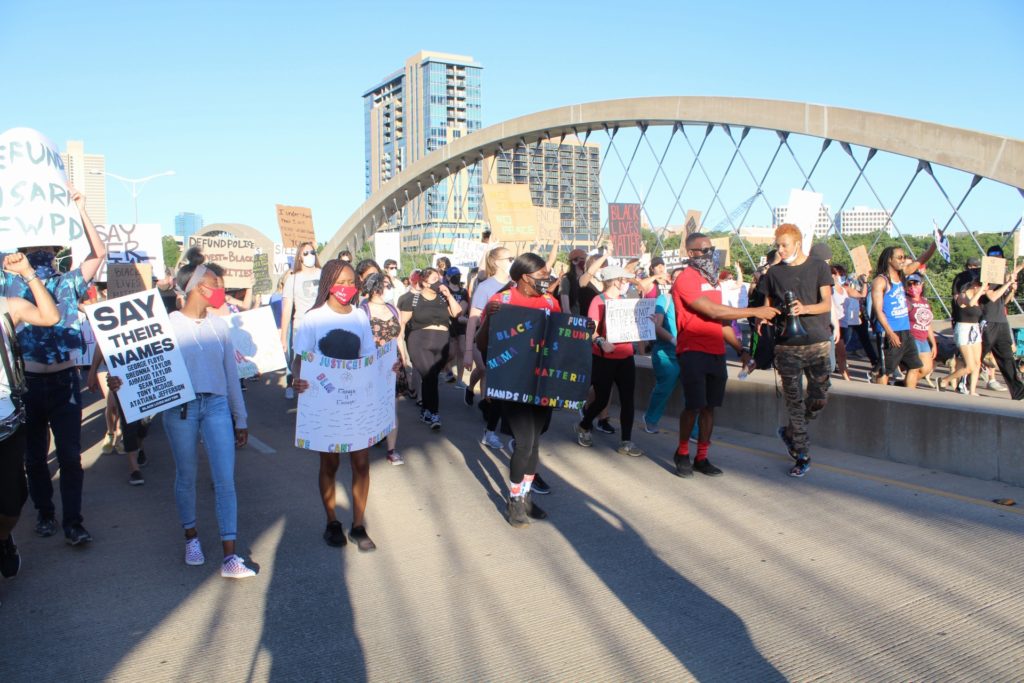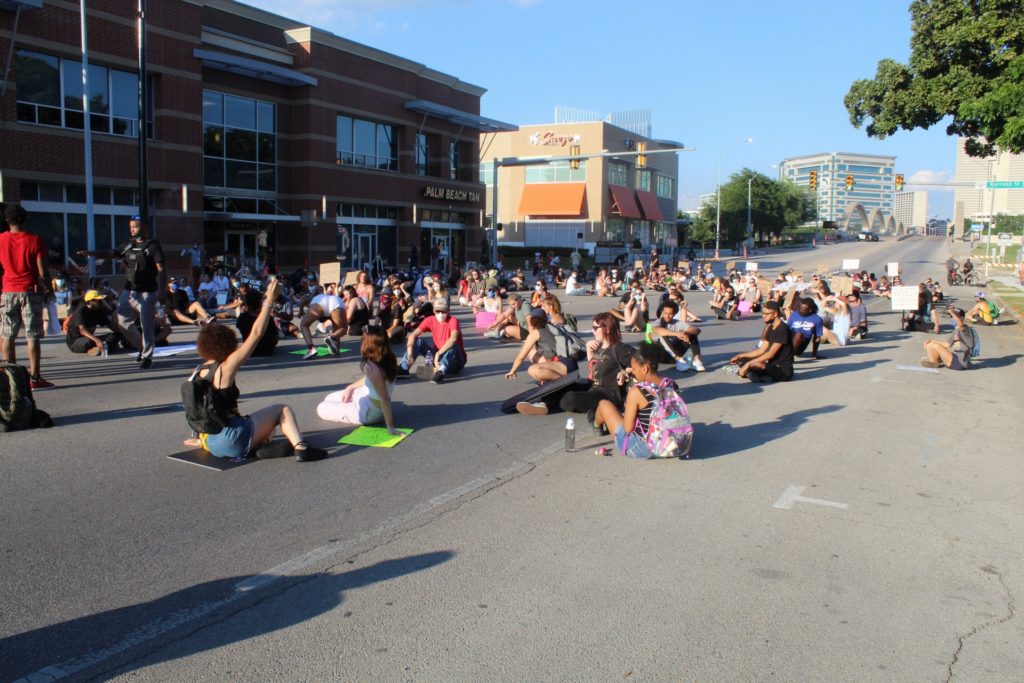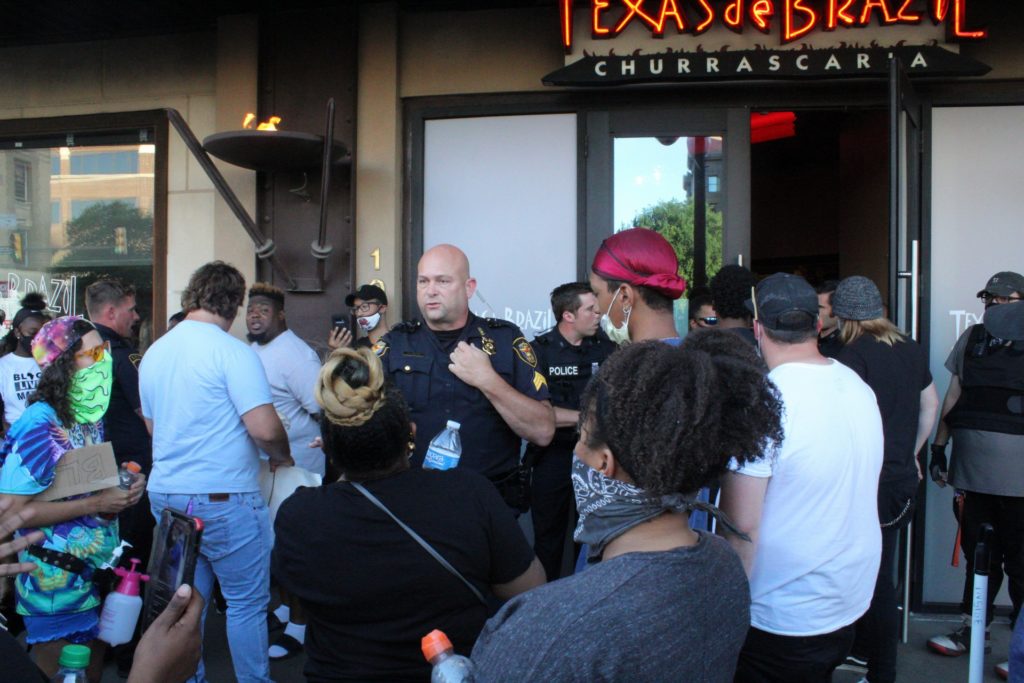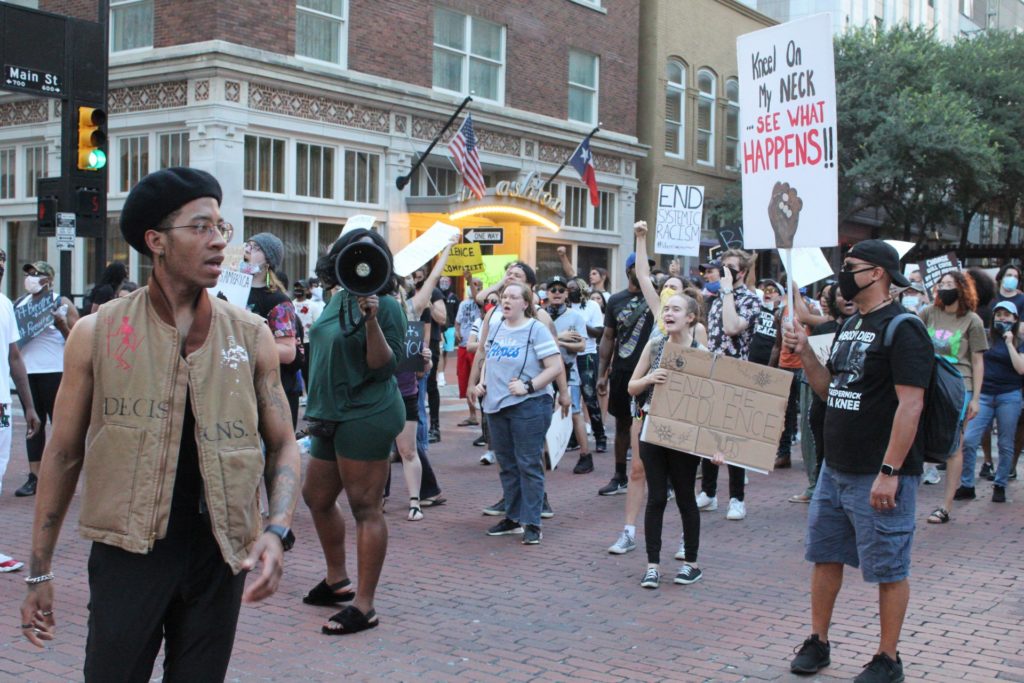An Insider’s View of the Fort Worth Protests
The past two weeks of protests in Fort Worth have been anything but predictable. The local Black Lives Matter movement grew spontaneously and now consists of numerous factions that are led by charismatic Black leaders. For two weeks straight, I have spent my evenings walking with, photographing, and documenting the movement that grew in response to the killing of George Floyd, a Black man, by a white police officer as three officers watched.

Protesters with Enough Is Enough marching over the West 7th Bridge. Photo credit: Edward Brown
Two weeks of covering the protests for a local newspaper have taught me that protests are physically grueling and mentally straining for every party involved. Early on, one question I repeatedly read online was, “What do they want?” The national movement is not just about Floyd, I’ve learned, although his murder sparked the social unrest.
The protesters have made their demands clear, and their calls for reform touch on criminal justice reform, economic justice, government transparency and accountability, and a host of civil rights issues.
Several moments of the protests have stuck with me. On the eleventh day, around 100 protesters sat on West 7th Street for an eight minute and 46 seconds moment of silence as one organizer addressed the crowd.
“Imagine dying slowly at the hands of an institution that is supposed to protect you,” she said.

Protesters sit for more than eight minutes to remember the death of George Floyd. Photo credit: Edward Brown
Days earlier while sitting under a shaded patch of grass near the Fort Worth Police and Firefighters Memorial, I overheard a youngish white male Facetiming a friend. Even with only one side of the conversation audible, I caught the gist of the debate over “all lives matter.”
“I understand that all lives matter,” the young man explained. “But right now, Black lives matter just a little more.”
The slogan “All Lives Matter” is not a rebuke of the Black Lives Matter movement but rather an admission that many people in our society are unable or unwilling to understand that this country’s core economic and political institutions were and continue to be founded on discrimination, sexism, and racism.
The idea that Black lives matter remains a radical notion in this country. When tasked with counting enslaved Black Americans, our founding fathers settled on the Three-Fifths Compromise in 1787, which counted Black men as three-fifths of a human being for electoral purposes. The practice of tipping began as a solution for white business owners who did not want to pay freed slaves for their labor.

As protesters have taken to flooding downtown restaurants with protesters, Fort Worth police department has stepped up intervention efforts. Photo credit: Edward Brown
The passage of the Fair Housing Act in 1968 protected homeowners and renters from discrimination based on race, but the act did not stop realtors from straying Black men and women away from white neighborhoods. The Federal Housing Administration refused to provide government-backed mortgage insurance near Black communities. The practice, known as redlining, was made illegal in the 1970s.
TCU history professor Max Krochmal recently interviewed an elderly Lloyd Austin who moved into the Riverside area only to witness a mob assemble to keep him from moving in. House bombings, mob violence, and cross burnings were used by white Fort Worthians to intimidate or try to kill local Black residents in the 1940s and 1950s, Krochmal said.

Lucid Shinobi (left) believes that racism will never end, but state-sanctioned oppression can be stopped. Photo credit: Edward Brown
When I asked protest leader Lucid Shinobi, a young Black man, about his hopes for ending racism, he said racism will never end. His aim is to stop state-sanctioned discrimination and oppression. The protest groups have shown signs of infighting from time to time, and their tactics have recently included the uninvited packing of restaurants with chants of, “F*** your peace!” The aggressive tactics have led to accusations that the protesters are bullies and agitators.
The protesters are aware of the alarm and distress caused by their actions. Feelings of unease are a daily feature of life as a Black man or woman, many of the protesters have said publicly. Each day, protesters arrive at the Tarrant County Courthouse unsure of what the police response will be. Each day, heavily armed police officers arrive unsure of what the protesters’ plans will be.
The most common refrain I hear from Black protesters is that they are tired. There is a collective awareness that rights in this country have to be fought for if you are a person of color. The Black Lives Matter movement in Fort Worth embraces other marginalized groups, including individuals from the LGBTQ and Latinx communities. Nobody knows how the protests will end. The leaders have made their intentions clear, though. The marches and economic disruptions will continue indefinitely until Fort Worth leaders agree to a wide range of reforms that show that Black lives truly matter.
 Edward Brown is a writing tutor and piano teacher. He is also an award-winning writer for the Fort Worth Weekly and volunteers for numerous Fort Worth nonprofits. He has spent the last two weeks walking and talking with the protesters in Fort Worth.
Edward Brown is a writing tutor and piano teacher. He is also an award-winning writer for the Fort Worth Weekly and volunteers for numerous Fort Worth nonprofits. He has spent the last two weeks walking and talking with the protesters in Fort Worth.


 Sign in
Sign in


